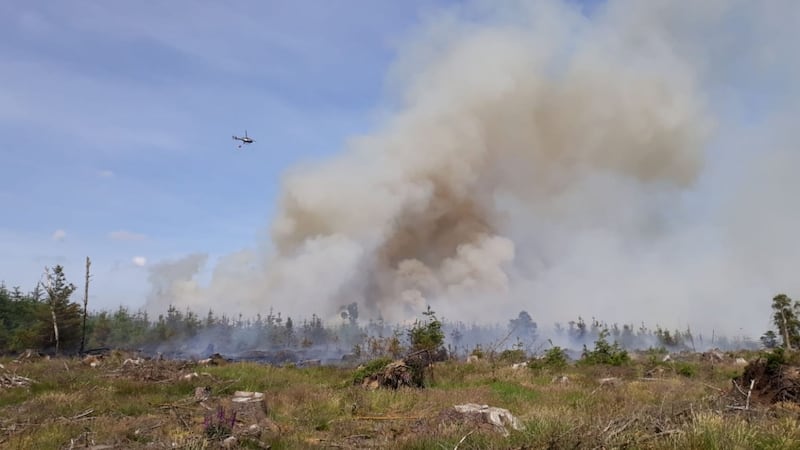Dublin Fire Service has appealed to people to be careful when cooking outdoors after three fire tenders dealt with a large barbecue fire in Stepaside in south Dublin.
The fire is believed to have started from a barbecue and spread to the bushes, fencing and decking of several houses. Fire crews prevented the fire from reaching the houses.
Fire tenders continued to deal with gorse fires raging rage across south Dublin and Wicklow as temperatures rise across the country.
Yesterday, we had difficulty accessing a large forest fire due to poor parking . ☀ today & if you're out & about, remember to park sensibly. We & other emergency services like @DWMRT @howthcoastguard need 24 hr access, thanks pic.twitter.com/1hNbmML28w
— Dublin Fire Brigade (@DubFireBrigade) June 24, 2018
And a tender was called to Portrane in north Dublin to deal with a vegetation fire. The fire service said householders in the area should close their windows to avoid being affected.
Three fire tenders were operating in Dublin and Wicklow to deal with gorse fires in Puck’s Castle, Barnaslingan in the Kiltiernan area, Shankill as well as a vegetation fire in Saggart.
The IFA is advising farmers to mind themselves and their livestock during the prolonged hot spell.
“The threat of forest fires has increased significantly and farmers should be vigilant to avoid damage to crops,” a spokesman said.
“The high temperatures pose a challenge to farmers, but it is important to remain safe and to avoid sunstroke.

“Ensure that livestock have adequate water supplies and shade from the sun.”
A Department of Agriculture orange warning for fire will remain in place until Thursday because of the ongoing dry and warm weather unless there is significant rainfall.
But Met Éireann predicts dry, warm weather until the weekend, when advancing weather systems are likely to have an impact because of a weakening of high pressure.
The highest temperature recorded at 1pm today was 23.5 degrees at Casement Aerodrome but meteorologist Klara Finkele said temperatures would increase further in the afternoon with up to 26 degrees expected in parts of the country.
The hottest weather of the year to date was reached on June 7th when temperatures soared to 26.1 degrees in Shannon and 25.8 degrees in Mount Dillon, Mayo.
Temperatures hit 22.5 degrees on Sunday in Gurteen, Co Tipperary and 23 degrees in Oak Park, in Carlow.
Temperatures are expected to reach 28 degrees on Tuesday in parts of the country. The high pressure keeping the warm weather in place is expected to weaken at the weekend and cloud between Ireland and Iceland is expected to affect Irish weather.
Use sunscreen
The Irish Cancer Society has appealed to people to take proper precautions to avoid sunburn and the increased risk of skin cancer. Most skin cancer in Ireland is as a result of over exposure to the sun.
The society advises that “whatever the weather from April to September protect your skin” and seek shade, wear shirts with a collar and three-quarter length sleeves and three quarter length trousers.
The society also urges people to use sunscreen with an SPF of at least 30 and a broad-brimmed hat.
As fire fighters continue to deal with gorse fires, Dublin Fire Brigade said it had difficulty accessing a large forest fire yesterday because of poor parking by motorists.
The fire service tweeted a photo of a fire engine blocked by a car from the entrance to a forest by a motorist out and appealed to motorists about today to “park sensibly”.
Irish Water said recent dry spells demand for water increases by between 20 million and 30 million litres a day which reaches and has exceeded the maximum capacity.
But the authority said that “current storage in the raw water reservoirs in the Greater Dublin Area, at Roundwood (Vartry) and Poulaphouca (Liffey) are reasonable and we do not see shortages at present. If the Summer and Autumn continues dry and hot, they may come under pressure later in the year.”
The Dublin region is currently using around 600 million litres of water a day which is close to the maximum level of water that can treated on a daily basis. The authority said that “if supply consistently meets or exceeds demand there may be water outages in the Greater Dublin Area as Irish Water manages the network and tries to minimize the impact on homes and businesses”.
The company’s drought management group is assessing supplies at risk which include the midlands, particularly Athlone and Mullingar, parts of Offaly, Kilkenny, parts of Donegal and the Greater Dublin Area where demand for treated water is regularly almost as great as supply.










